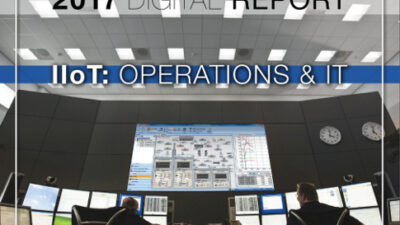Maximize reliability, speed, and ease of operation and maintenance by by selecting an appropriate motion control network.
If a machine or a robot needs motion control, odds are the automation system will use a high-speed digital motion control network. These networks provide a host of benefits (synchronized, time stamped, with updates in the millisecond range with microsecond jitter or better). However, designing these networks requires care to simultaneously attain high reliability, maximum speed, low cost, and ease of operation and maintenance. Many motion control applications are speed-critical, with faster speeds resulting in higher throughput. As speed increases, motion control network design details become even more important. Information below shows how to maximize motion control network reliability and speed, guarantee operability among motion control components, minimize cost, and ensure ease of operation and maintenance.
The need for high speed
Almost every modern digital motion control network is Ethernet-based, but significant differences exist at the protocol level and within the communication hardware included with each motion component. Typically, each motion component will have a communications chip that enables it to talk to other components in the network. The protocol and the chip work together to optimize communications for the particular task at hand (in this case, motion control). When evaluating Ethernet-based motion control networks, it’s critical to check that all of the key requirements listed in Table 1 are met. The relative importance of each requirement will depend on particular characteristics of your application. Selecting the right motion control network will ensure that your machine or robot produces parts correctly with maximum speed.
The most important requirements for a motion control network are reliability and high speed. Most modern motion control networks are very reliable, minimizing component failure, so operational reliability depends on other factors, namely error checking and quick recovery from any errors. These features are critical because they allow parts to be produced correctly. High speed is important because it results in maximum throughput. Simply put, more speed equals more parts produced.
Machine or robot motion control commands are typically sent from a main controller to motion control components. These commands include information such as the desired position, velocity, and/or torque. In turn, the motion control components often send data back to the main controller to indicate actual motion control parameters. To ensure guaranteed high speed, all data should arrive quickly and intact. In rare instances where data becomes corrupt or lost, the network should detect the problem and respond accordingly.
A prime example of this is a computer numerical control (CNC) application. A CNC relies on the correct data to arrive at the motion control components so that the cutting tool will cut the correct shape. If any data is missed, the CNC will either use the motion data from the previous packet or extrapolate the information based on previous data points to make a guess (see Figure 1). This missed data can adversely affect product quality.
A quick solution to missed data is simple: When there is any kind of error, the machine could completely stop and start over. The drawback to this approach is that the machine will have to be restarted many times if the system is sensitive to noise or has other operating issues that cause frequent data losses.
A better solution would be a communication network that automatically resends data if any data become corrupt. The Mechatrolink motion control network, for example, checks to make sure that all motion control components receive data sent by the main controller, and this is done immediately after the initial data send. If any of the motion control components received corrupt data, the Mechatrolink motion control network will resend the data for only those components. The new data is sent within the same cycle as the original data, with the resent data now located at the end of the data stream (see Figure 2). Resent data are included within the same communications cycle to maximize possible recovery speed. This data resend feature is useful for guaranteeing correct data arrival every communications cycle, and it allows the system to operate well in noisy environments.
Determining actual speed
Operating speed for Ethernet-based communications such as Mechatrolink, SERCOS, Profinet, and EtherNet/IP is typically 100 Mbps. However, actual application speed depends on how quickly the motion control system can perform consecutive operations, which is driven by the cycle time.
The two most important variables that determine the cycle time are the amount of data that is sent to each motion control component and the total number of components. Most, if not all, Ethernet-based motion control networks allow the amount of control data sent to each motion control component to be changed according to the application requirements.
Actual speed under operating conditions tends to be a mystery in many Ethernet-based motion control networks. The actual speed must account for all of the variables that determine cycle time. Some motion control network organizations, such as Mechatrolink, provide a utility that allows the user to input the network architecture and calculate cycle time (see Figure 3).
The Mechatrolink cycle time utility takes into account the amount of data sent to each motion control component, the total number of components, the length of the communication cables between, the use of hubs, and all Mechatrolink chip delays. This utility helps to determine if the designed motion control network architecture is operable at the desired speed.
Importance of compatibility
Another requirement when selecting a motion control network is availability of interoperable components. Most machine and robot builders have preferred suppliers for their automation components, and it’s critical that these components are interoperable in an integrated motion control system.
Ethernet-based motion control network organizations typically offer a conformance test to check if components can comply with the communications protocol. It’s also common policy for the organization to prohibit the use of the communication technology’s logo on the component unless the conformance test has been passed. Table 2 shows some suppliers with conforming components for Mechatrolink, a motion control network.
For example, a machine or robot automation system might include a main controller, remote I/O, a vision system, and servo motor drives. The best performance and lowest price for such a system could result from mixing and matching different vendors. Motion control networks with a wide variety of available interoperable components offer more choices to match application needs.
Even if components are carefully selected during the design phase, actual commissioning could reveal that one particular component isn’t a good fit—for instance, if the selected remote I/O doesn’t perform as expected or the vision system has limitations that weren’t evident in initial design. Interoperable components allow needed changes to be made without affecting the viability of the rest of the automation system.
The ability of Ethernet to simultaneously carry multiple protocols may seem to offer an opportunity for mixing and matching of communications protocols and automation components, but mixing protocols can cause problems. An Ethernet-based motion control network is less prone to problems when there is only one protocol rather than two or more communication protocols. Some Ethernet-based motion control networks have two built-in protocols with the first acting as a carrier for the second.
Fortunately, this isn’t the case with many well-known motion control networks such as Mechatrolink, SERCOS, Profinet, and EtherNet/IP. Each of these networks features one complete protocol, uses conformance testing, and authorizes use of its logo only on components that have passed the conformance tests. This results in guaranteed interoperability when designing a motion control network that uses components from different vendors.
Hot plug and play, easy maintenance
Another key factor when selecting a motion control network is ease of operation and maintenance. As previously discussed, the right motion system network can increase uptime and ease operation through automated error detection and recovery. A standard maintenance procedure in many plants is to shut down a production line to perform maintenance on just one section of a machine or robot. This procedure is required with networks that require a restart when any part of the communications system is disconnected or when any communications error is detected.
A more effective maintenance procedure is to allow the machine or robot to stay on by using hot plug and play. Many Ethernet-based motion system networks, including Mechatrolink, SERCOS, Profinet, and EtherCAT, offer hot plug and play. This allows motion control components to be added or replaced without interrupting communications among the main controller and other components.
This network architecture (see Figure 4) is easy to implement when there’s a wide range of interoperable products from which to choose. Motion control components can be swapped in and out while the machine is running.
Derek Lee is a motion product engineer with the drives and motion division of Yaskawa America.
Also read:
High Performance Industrial Networks, offering research and analysis from Control Engineering


